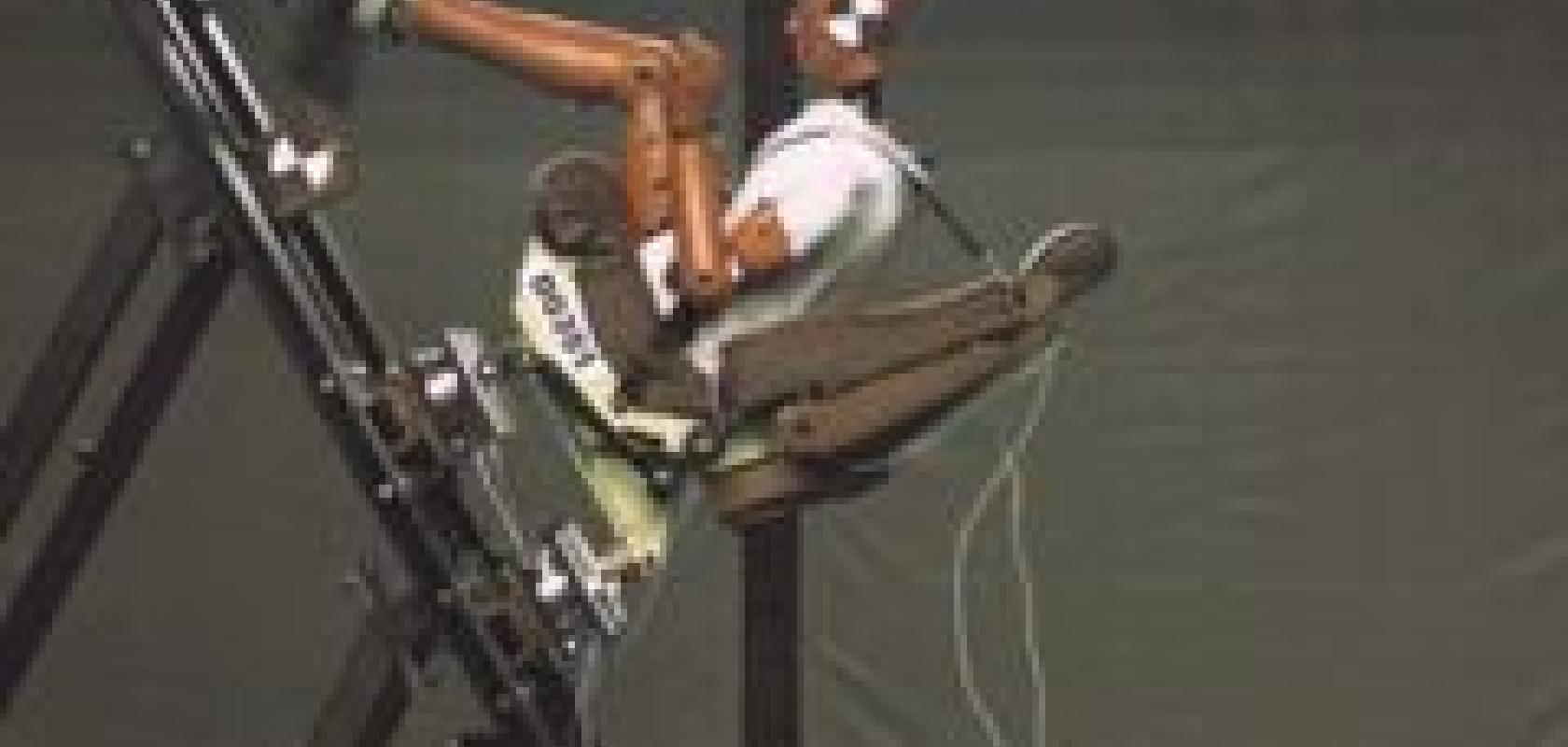Those watching the BBC’s coverage of the big sporting events this summer – the Beijing Olympics, Wimbledon, Test Cricket – will have seen examples of high-speed imaging. The super slow-motion camera work can prolong the action to give a perspective that would otherwise be impossible to see. Rafa Nadal’s whipping forehand, for example, can be slowed down enough to analyse in minuscule detail. The BBC series Planet Earth also used high-speed cameras to great effect in its celebrated footage of a Great White Shark attack off the coast of South Africa.
High-speed cameras provide the ability to slow down events that, in real-time, would be too fast for the human eye to see, allowing them to be analysed in much greater detail. Broadcasting is one area where high-speed imaging is beginning to find uses, but there are a whole range of industries and applications that utilise high-speed cameras. Ballistics research and automotive crash testing are two such areas, as is fault-finding in high-speed machinery. ‘These applications require the camera to capture as many samples as possible over a short period of time,’ explains Mark Williamson, UK sales and marketing director at Stemmer Imaging, a European provider of imaging technology.
‘A company registering a fault with its printing machinery, for instance, can use high-speed cameras to capture footage of the machine in use and analyse frame by frame where the fault lies,’ says Williamson. The mechanics of the machine are moving too fast for the human eye to see, so high-speed imagery is used to slow the event down for analysis.
Traditional record/playback machine vision cameras are online systems, in that the camera sends data packages back to a computer for storage on hard disk space. ‘Currently, the fastest method of getting the information from the camera to the PC is via Camera Link cabling, which affords a frame rate of around 500fps – at 1.4 Megapixels that’s a data transfer rate of 700Mb/s,’ says Williamson. This is reasonably fast, and with windowing that rate can be increased to 1,000 or 2,000fps. Mikrotron, Optronis and Basler all supply cameras that can reach these frame rates, and because the data is stored on a PC, recording can continue for long periods of time.
However, there are some applications where 500fps is not fast enough. In these cases, the memory moves from the PC to inside the camera, which allows a tenfold increase in frame rate to around 5,000fps with still the option of windowing to increase the frame rate further. It’s these cameras that Williamson identifies as being ‘high-speed’.
‘If still higher frame rates are required, the bottleneck moves from the interface between the camera and PC to the sensor output,’ explains Williamson. Ultra high-speed cameras can operate at rates exceeding one million frames per second, applications for which are very specialised and include ballistics testing. At these frame rates, information can’t move out of the sensor quickly enough so it’s stored in the sensor. The drawback is that the sensor’s storage capacity is only approximately 16 frames, which puts limitations on the camera’s use.
Ballistics testing is generally where frame rates must be highest and where the development of high-speed cameras is most specialised. The ability to capture the effects of bullets or other high-velocity projectiles requires ultra-fast frame rates. Jonathan Hatton, global application specialist for the i-Speed high-speed video product range at Olympus, explains: ‘Ballistics need the highest possible resolution at the highest possible speeds along with additional features such as IRIG (Inter Range Instrumentation Group) and GPS (Global Positioning System) frame stamping and the facility to synchronise multiple cameras accurately.’
One of the problems with capturing images at high speeds is that exposures have to be quick and therefore require lots of light. Automotive crash testing facilities, for instance, will rig up floodlights to get the correct lighting levels. Hatton comments: ‘Higher speeds invariably mean lower resolution and darker images, although great strides are continually being made in this area.’
High-speed cameras typically use CMOS sensors, whereas most other vision systems use a combination of CMOS and CCD. There are exceptions, and Hamamatsu Photonics has developed a range of CCD sensors that overcome the issue of low sensitivity with higher frame rates by synchronising the charge transfer, line by line, with the movement of an object. ‘Exposure takes place on each line and hence sensitivity is increased,’ explains Craige Palmer, assistant sales manager in the Components Division at Hamamatsu. Over the past six months, Optronis and Mikrotron have also introduced new sensors, which are 10 times more sensitive than previous models, therefore requiring less light.

Hamamatsu’s range of TDI CCD sensors are designed for high sensitivity and are suited to high-speed imaging.
Optronis also employs multi-slope technology to handle the high dynamic range associated with some applications of high-speed imaging. ‘Multi-slope technology involves controlling the exposure of each pixel based on the intensity so that dark areas get more exposure and bright areas less,’ says Williamson. If, for instance, the camera is recording footage of a spark, multi-slope technology allows the entire image to be correctly exposed.
Triggering is important. If the event occurs at speeds faster than the human eye can see, which is largely the case, then knowing when to capture the footage can be difficult. ‘High-speed cameras contain up to 16GB of internal memory, which provides about 22 seconds of recording, so they can’t be left running for long periods either side of the event,’ says Williamson. A ring buffer provides continuous recording and a trigger is set up to identify the event so that upon capture, images before and after the event are recorded. This trigger can be an input signal or via the camera, where a change in the intensity of a specific area associated with the event acts as the trigger.
Olympus’ Hatton notes a gathering of pace in the technology over the past 10 years with a move away from the use of high-speed film cameras to digital systems. ‘The film cameras were good, but the film was costly to purchase and time-consuming to process. A lot of film was wasted bringing the cameras up-to-speed,’ he says. ‘Also, a very high level of expertise was required to operate the systems and because of how they functioned, there was a lack of confidence surrounding the capture of each event. Modern digital high-speed systems operate much more along the lines of consumer camcorders and offer reliability and repeatability of analysis via powerful PC software packages.’
Hatton views high-speed cameras and industrial cameras as working well together. ‘Industrial vision cameras work to a maximum of a couple of hundred frames per second, and use a fast shutter speed to stop the motion and automated analysis software to identify deficiencies in the product,’ he says. ‘A machine vision camera will tell the operator that there is a fault and a high-speed camera will help to identify the cause of the fault.’
Palmer of Hamamatsu says that end users are looking for higher speeds while maintaining a sufficiently good signal to noise ratio and resolution. Hatton agrees. ‘Existing users are demanding physically smaller cameras with higher speeds at full high-definition resolution, as well as greater light sensitivity,’ he says. 3D high-speed video is also an area where Hatton expects growth: ‘The intention will be to merge and compare 3D images with CAD drawings to assess the accuracy of those CAD designs, ultimately to reduce the cost of repeated testing.’
The braking systems of France’s Train á Grande Vitesse (TGV) express trains have been under analysis by high-speed infrared cameras from Flir Advanced Thermal Solutions (ATS) (formerly Cedip). The study, commissioned by the French national rail operator SNCF, aimed to investigate how effective brake disks were at managing the heat load produced during an emergency stop. Flir ATS is part of Flir Systems.
TGV trains reach speeds of 300km/h and to make an emergency stop within the mandatory 3,500m braking distance, each brake disk has to dissipate 14MJ of energy within 80 seconds. ‘Localised heating, in the form of “hot spots” on brake disks subjected to this frictional force can be extremely dangerous, causing parts to deform or fail,’ says Pierre Brémond, business development manager at Flir ATS.

Infrared image of a brake disk from a TGV express train during an emergency stop. The image was captured using Flir’s high-speed infrared camera.
To understand how hot spots are generated, the team – with the support of the Ecole Polytechnique Universitaire de Lille – measured the temperature of brake disks during braking on a full-size test bench using Flir’s high-speed infrared camera. The camera operates at 400fps at full frame rate and, with windowing, can capture images at 25,000fps.
Hypercalibration allows users to select any integration time and automatically recalculate the calibration time. The cooled camera was set with 12s integration time in order to take a clear snapshot of a segment of the spinning disk. ‘Four or five snapshots of different segments of the disk were taken per rotation, and accurate triggering was required to capture the same portion of the brake disk with every cycle,’ explains Brémond. ‘Brake Recomposer software was then used to stitch together the individual segments to get a thermal image of the entire brake disk for each rotation.’ This allowed engineers to study the type of hot spot generated over time as well as the thermal stress placed on the brake disk material.
‘Hot spots vary in size and shape, but can show temperature gradients exceeding 1,000°C,’ says Brémond. The properties of materials used to manufacture brake disks can change with these temperatures and work is still ongoing to identify materials that dissipate heat effectively and that reduce the formation of hot spots.


